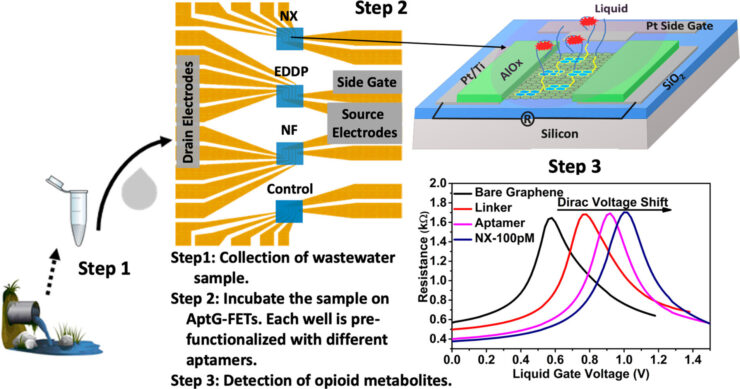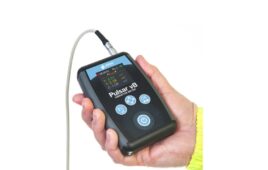Researchers at Boston College, Giner Labs and Boston University say the answer is a graphene electronic multiplexed sensor (GEMS) platform that enables the simultaneous sensing of four different target opioid-derived molecules in wastewater samples. The graphene-based field effect transistors detect four different synthetic and natural opioids, while shielding them from wastewater’s harsh elements.
The ability to rapidly, cheaply, and easily measure opioids in wastewater, means the technique can be applied on a local scale such as block-by-block or dorm-by-dorm testing and ensure the privacy of those in the tested area. With the ongoing opioid epidemic, determining the amount and kind of drugs being used in a community is part of the approach public health official could implement to deal with the problem. The technique is similar to testing wastewater to measure community levels of coronavirus infection during the pandemic.
The graphene probes have aptamers or short, single strands of DNA that only attach to specific metabolites of various opioids in wastewater. Attachment of the aptamer to the drug causes it to fold, creating more charge. Monitoring the amount of charge on the graphene allows the detection of the presence of a specific opioid metabolite.
The penny-sized, multiplexed bio-sensors and the portable nature of the measurement device would allow wide scale, on site population testing at low cost and high geographical resolution. Previous techniques involved shipping of samples and testing in a laboratory setting. In addition to the timing aspects of the process, those requirements impose costs that limit wide adoption and use in communities with insufficient resources. The graphene device overcomes these limitations and can provide nearly real-time monitoring in multiple locations. This could also help distribute resources such as first responders or specific intervention strategies.
Resources:
“Graphene sensor rapidly detects opioid metabolites in wastewater,” https://phys.org/news/2022-02-graphene-sensor-rapidly-opioid-metabolites.html
“Rapid, Multianalyte Detection of Opioid Metabolites in Wastewater,”
Narendra Kumar, Muhit Rana, Michael Geiwitz, Niazul Islam Khan, Matthew Catalano, Juan C. Ortiz-Marquez, Hikari Kitadai, Andrew Weber, Badawi Dweik, Xi Ling, Tim van Opijnen, Avni A. Argun, and Kenneth S. Burch
ACS Nano 2022 16 (3), 3704-3714
DOI: 10.1021/acsnano.1c07094
Filed Under: Sensor Tips




